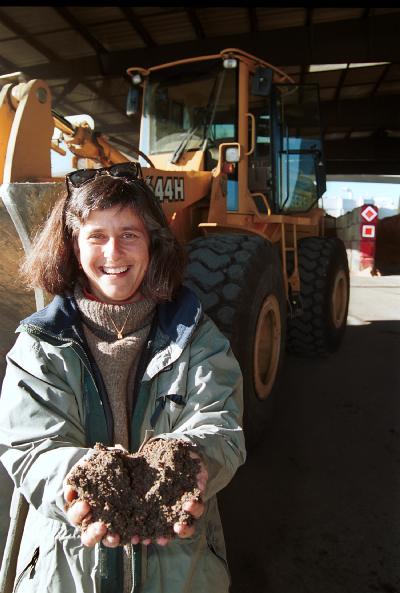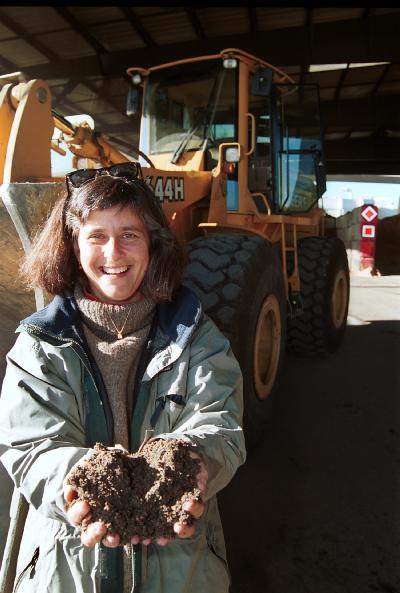November 21, 2002
SoHo to soil: Brown has come a long way
Ask Sally Brown to compare her former career as a chef with her current career as a soils scientist and one can expect a simple answer: “The cooking smells better.”
Brown, a New York City-born research assistant professor of forestry, has worked as a chef in a trendy SoHo restaurant, formed a wholesale produce business out of the backseat of her mother’s Chevy Nova, and now cleans up highly contaminated EPA Superfund sites with a revolutionary and relatively inexpensive approach.
If her career path seems random and patchwork to others, it seems, well, simple to Brown. For example, how does one go from being a chef to a career in academia? Simple, really: “Graduate school.”
At some point during her undergraduate program at Williams College in Williamstown, Mass., Brown realized that her liberal arts education was lacking one thing. Most of the students on the campus were political science and art history majors. Brown planned to be a journalist. But writing about other peoples’ accomplishments was less than satisfying.
“It began to feel like I had no real skills,” she said. “I wanted to know how to do something and be able to make something. I always had loved to cook and it occurred to me that, ‘You know, this is a skill. I could do something and I could have concrete results. How do you like that?’ ”
At the age of 13 Brown learned to make an apple pie. Soon after, she also discovered that chocolate pudding could be made from scratch. While in college she loved to host dinner parties. But the pinnacle of her culinary career came one morning as she worked the buffet at the SoHo Charcuterie.
“Warren Beatty had my French toast while he was eating with Diane Keaton,” she recalled. “Right after that the restaurant was closing for several weeks of vacation and I was going to fly to Spain after having fed Warren Beatty and watching him chew. When you’re 22 that’s a big thrill. When you’re closer to 30 it’s like, ‘Wait, I’m not eating with him. I just got his dirty plate. That’s no good.’ ”
Now Brown cooks up solutions to some of the country’s most toxic environmental problems. In Joplin, Mo., she helped turn 25 acres of smelter waste into a safe haven for bobcats and coyotes and other wildlife. Near Coeur d’Alene, Idaho, Brown and her colleagues restored a healthy vegetative cover to land that had been scarred by more than 60 years of mining. And high in the Rocky Mountains of Colorado, Brown and company cleaned up mine waste that had destroyed the upper Arkansas River ecosystem.
“One thing I like about what I do is you get really nice before and after pictures,” Brown said.
The key ingredient in her restorative recipe is nothing she would serve to Beatty, Keaton or anyone else for that matter. But biosolids, the residual byproduct generated by the wastewater treatment process, are powerful tools that Brown and others in the industry use to turn environmentally hazardous sites into healthy landscapes.
Brown is one of the pioneers of the still controversial technique that began about 10 years ago in Pennsylvania. Biosolids contain metals and pathogens, which makes them unsafe for many purposes. One wouldn’t want to grow tomatoes in biosolids, for example. Metal concentrations have decreased with pre-treatment regulations, and processes exist for removing the pathogens from the material.
In King County anaerobic digestion — curing without air — removes much of the pathogens. In Everett the material is stored in lagoons that can be seen from Interstate 5. In both cases bacteria are eating the material, including the pathogens, and then dying. As a result the amount of pathogens decrease.
Brown and a handful of others like her theorized that the material could be used at polluted sites to soak up the metals that were already in the ground and keep them from being taken up by plants or leeching into the water supply. Essentially, the application of biosolids makes the metal inaccessible. The method is revolutionary because it’s much easier and less expensive than removing the metals or removing the soil.
But Brown is also attracted to the technique because of the symbiotic relationship it fosters. The waste is created in a municipality and can be put to use in rural areas, where much of the old mining cleanup occurs.
“One thing that’s nice is that it strengthens the tie between rural and urban. It creates sort of a mutual dependence.”
Her appreciation for rural life goes back to childhood and this isn’t the first time she has intersected city and rural life during her professional career.
“I’m a city girl who likes the country life,” she said. “I guess I watched too many Green Acres reruns, what can I say? Or I’m a country girl who likes a latte and a New York Times on her plate every morning.”
That appreciation for all things rural began when she was a child. The family used to plan summer vacations according to the whims of their collective taste buds. Farmers from the nearby region would be selling produce to Long Island vacationers from the back of a pickup. If Brown and her family wanted to eat fresh, locally grown strawberries and peas they’d vacation in June. If they wanted corn and tomatoes they’d go in August.
During those vacations she began to learn that a tomato can come in a variety of shapes, sizes, colors and tastes. A range of varietals were available from the farmers that weren’t in the grocery stores near her family’s home. At some point during her career as a chef she realized that an untapped market existed for those farmers and then her wholesale produce business was born.
She started bringing in-season, locally grown produce from the farms to the grocery markets and restaurants in the city. The idea caught on. From the humble beginnings of her mother’s Nova the business grew rapidly.
“At the end I had an Isuzu, refrigerated six-wheel cube van with a 14-foot box,” she recalled. “My last year, my gross in five months was something like $150,000. But, it was seasonal. It was really hard. I wanted to continue to work with farmers, but coming from Queens, I didn’t envision myself living in Nebraska.”
That’s when she made the transition to academia, first getting a master’s and Ph.D. from the University of Maryland then beginning her work at the UW in 1998. She gets plenty of opportunities to connect with the rural lifestyle during her current job.
And from time to time she still gives in to the cravings from her childhood. She bought some raspberries and currants — wholesale, of course — from a farmer near Fife during the summer in order to make some jam.
“I still love to cook. It’s how I relax now.”




